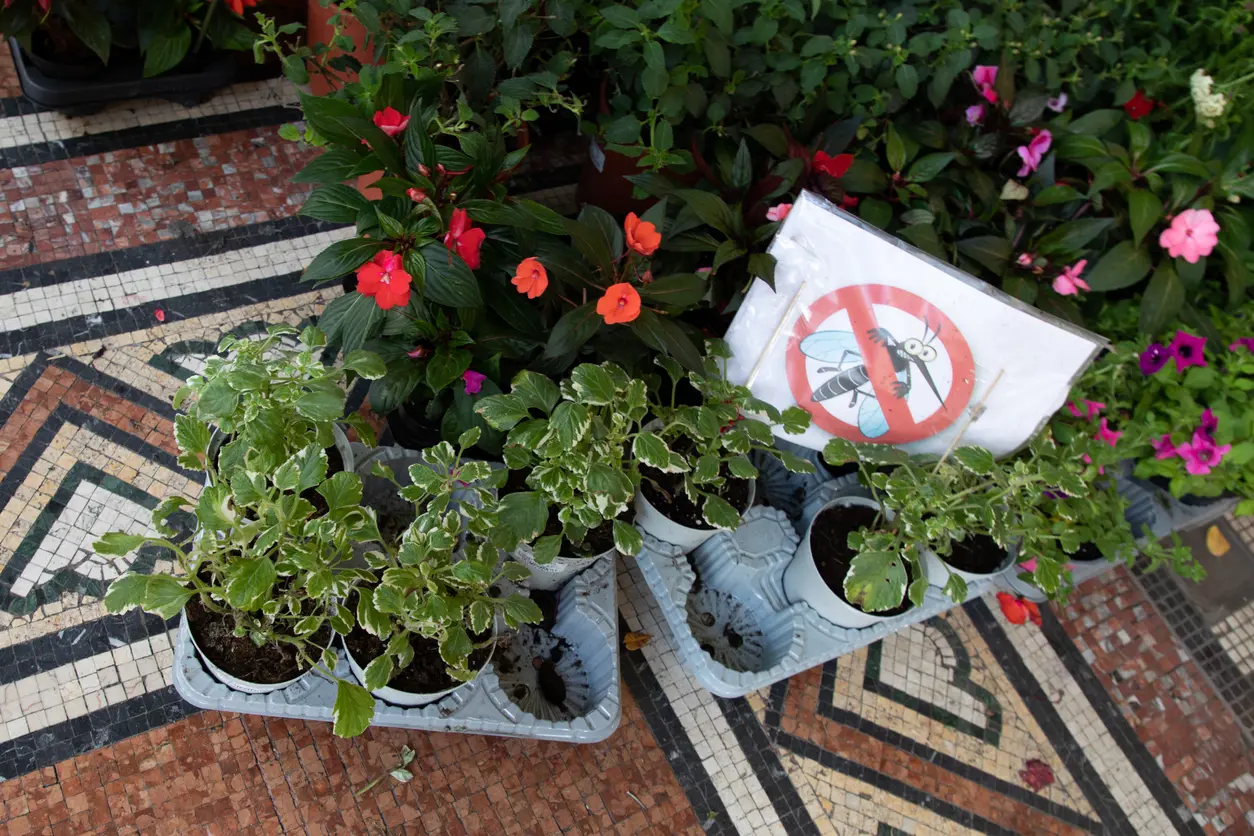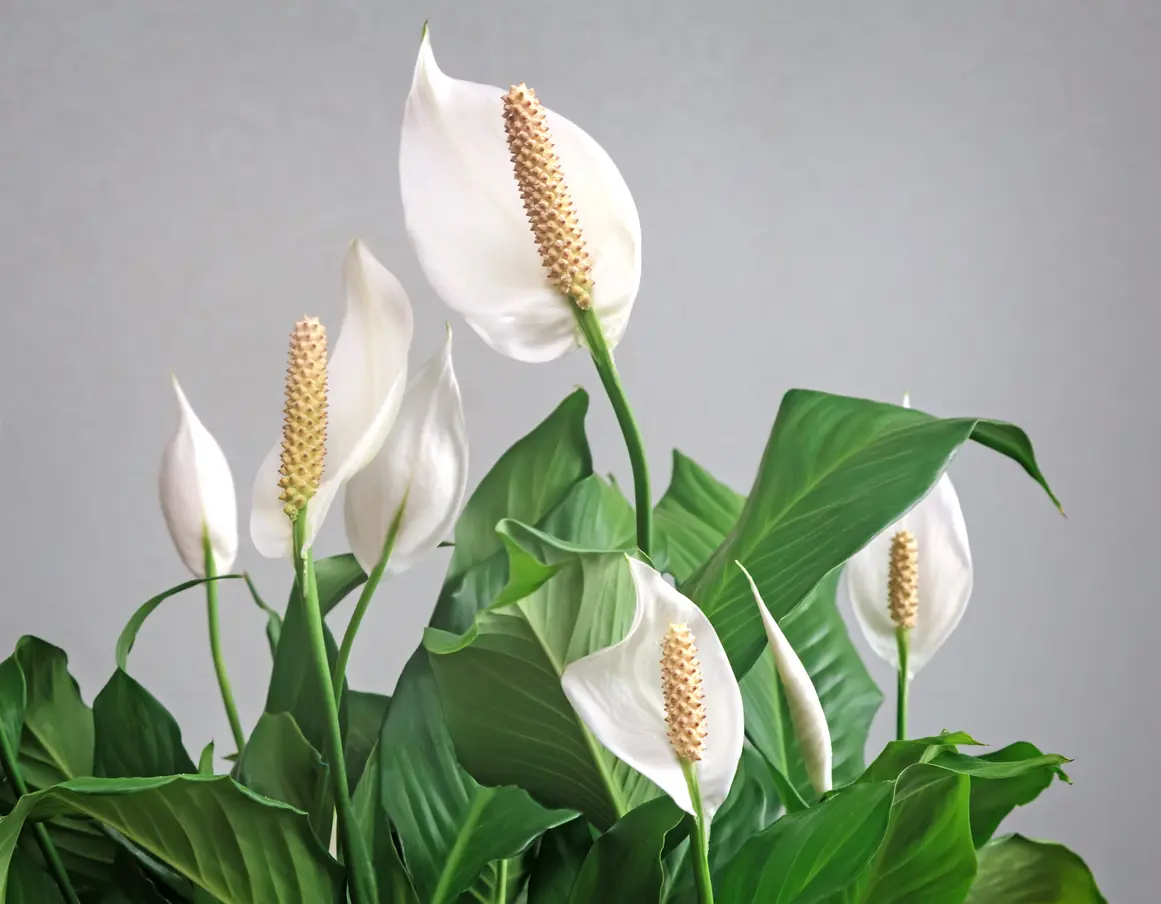
It seems like everyone who’s ever owned houseplants has cared for a snake plant at least once, and rightfully so! They’re minimalistic plants that don’t require much, are hard to kill, and can clean the air by removing harmful toxins.
Learn how to care for these beginner-friendly plants in this snake plant indoor guide. If you want to freshen up your apartment or add a pop of color to your patio, you can do so with Sansevierias.
Snake Plant Types
The Dracaena (formerly Sansevieria) family boasts over 70 species, each with many different cultivars, so there’s sure to be something that will suit your style. Though they have tropical vibes, they’re from dry regions in southern Asia and Africa.
Perhaps the most popular variety you’ll find in plant nurseries is Dracaena trifasciata. They’re known for their tall, pointed leaves with gorgeous variegated coloration:

- 'Laurentii’ is known for green stripes and bright yellow edges.
- ‘Moonglow’ boasts silvery hues and dark green edges.
- ‘Hahnii’ are short plants growing in a rosette.
- ‘Bantel’s Sensation’ will grab your attention with its height and vertical stripes.
Other varieties you won’t want to miss include:
Dracaena hanningtonii ‘Samurai Dwarf’:
The leaves form an intriguing zig-zag pattern on the side as the red-edged leaves grow from the center.
Dracaena pethera (formerly Dracaena kirkii) ‘Coppertone’:
- These leaves have a unique splotchy pattern with copper hues.
Dracaena masoniana:
- Often called the “shark fin” or “whale fin” snake plant, this species is typically sold with just one or two leaves and looks like a fin sticking out of the soil.
Dracaena angolensis:
- While most snake plants resemble swords, this species has tubular leaves ending in a point, giving it a marine or otherworldly appearance. [1] Snake Plant: A Forgiving, Low-maintenance Houseplant; Penn State Extension
Light and Temperature Needs
Knowing how to grow snake plants is rewarding, and it all starts with understanding their light and temperature requirements. These happy-go-lucky plants thrive in just about any indoor environment, provided it’s not too cold. Avoid drafty areas and keep the room temperature over 70 degrees Fahrenheit.
As for sunlight, avoid direct rays as much as possible. Bright, indirect light is the best thing you can do for snake plants. If your plant doesn’t have a sunray on it but can still cast a shadow, you have the right amount of light. [2] Yard and Garden: Caring for Sansevieria; Iowa State University Extension and Outreach; Aaron J. Steil
The hardy snake plant forgives low-light situations and should hold up in most areas. [1] Snake Plant: A Forgiving, Low-maintenance Houseplant; Penn State Extension But, the less light you have, the less color variegation the plants will have. Solid green cultivars are the best for low-light areas since they won’t lose their color patterns. If you have a room with direct sun or very bright indirect lighting, Dracaena angolensis is more tolerant than other species. [4] How to grow sansevierias; Royal Horticultural Society
In the summer, you can move your snake plants to a sunny patio to encourage new growth, but avoid putting them in the sun in the heat of the day, or they’ll burn. [3] Plant of the Week: Snake Plant (Mother-in-Law’s Tongue); University of Arkansas Division of Agriculture , [4] How to grow sansevierias; Royal Horticultural Society
Soil and Potting Tips
The best soil for snake plants won’t hold on to extra water. It should drain quickly to prevent the roots from being exposed to standing water. Choose soil for cacti or mix potting soil with perlite. [1] Snake Plant: A Forgiving, Low-maintenance Houseplant; Penn State Extension
Snake plant care is easy because they can go a long time without water, but choosing the wrong soil will cause you eventually kill them. Surprisingly, the pot size can contribute to overwatering snake plants because more soil means more moisture, and that leads to root rot.
Another reason to keep the pot size small is that snake plants like to be snug. Keep your plant in its original pot until it outgrows it. You can always place the original pot inside a decorative pot if “plant nursery chic” isn’t your style! [4] How to grow sansevierias; Royal Horticultural Society
Repotting snake plants won’t happen very often. You’ll know it’s time to do so if there isn’t much soil left in the pot, roots poke out of the bottom, or the clay pot cracks and breaks. When you upgrade the pot, choose something heavy to prevent the plant from becoming top-heavy in dry soil. [1] Snake Plant: A Forgiving, Low-maintenance Houseplant; Penn State Extension , [4] How to grow sansevierias; Royal Horticultural Society
Watering Schedule
Snake plant watering is as simple as waiting until the soil is bone dry from top to bottom. [2] Yard and Garden: Caring for Sansevieria; Iowa State University Extension and Outreach; Aaron J. Steil Snake plants have succulent leaves that hold water, so they’re never in short supply.
When it’s time to water, water from the top and avoid getting the plant wet. After you water the plant, remove any standing water so the soil can’t soak it up. You won’t need to water in the winter unless it’s kept in a warm room.
Snake plants don’t need much humidity, so keep them out of bathrooms. Misting the leaves could also cause the plant to become too moist and suffer root rot. [4] How to grow sansevierias; Royal Horticultural Society
Fertilizing and Feeding
You won’t need to fertilize your snake plant very often, if at all. However, giving it a boost in the spring will encourage a growth spurt. [2] Yard and Garden: Caring for Sansevieria; Iowa State University Extension and Outreach; Aaron J. Steil
Choose an all-purpose, cactus, or houseplant fertilizer. Dilute it down to quarter or half-strength and feed your snake plant in the spring or throughout the growing season, which typically lasts from spring through fall. [4] How to grow sansevierias; Royal Horticultural Society
Be careful not to overfeed your plant. Common signs are leaves wilting or turning yellow or brown, fertilizer crusting up on the soil, or the plant showing no signs of new growth. [8] Over-Fertilization of Potted Plants; Penn State Extension
How to Propagate Snake Plants
When you learn how to propagate snake plants, you can grow your collection all on your own or share them with your friends. Division and cuttings are the two main ways to propagate.
Propagating by Division
Snake plants will grow new offspring after a few years. Division allows you to separate those offspring and grow replicas of the mother plant. You can also use this method for large snake plants you want to make smaller.
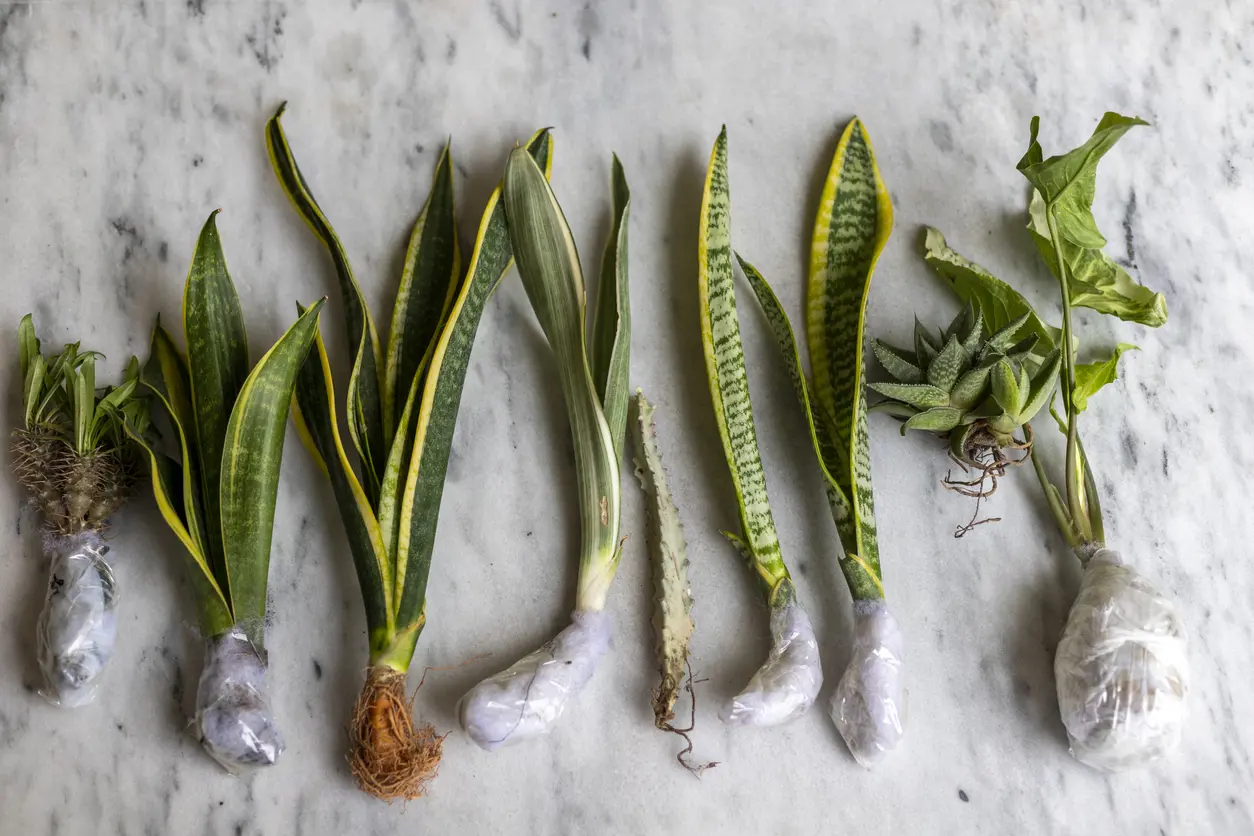
To divide your snake plant:
- Remove the snake plant and its offspring from the pot.
- Separate the offspring from the mother plant, or large clumps from the same plant.
- If necessary, cut through large plant rhizomes, ensuring every piece has roots intact.
- Once separated, repot the snake plants in the appropriate soil. [2] Yard and Garden: Caring for Sansevieria; Iowa State University Extension and Outreach; Aaron J. Steil
Propagating by Cuttings
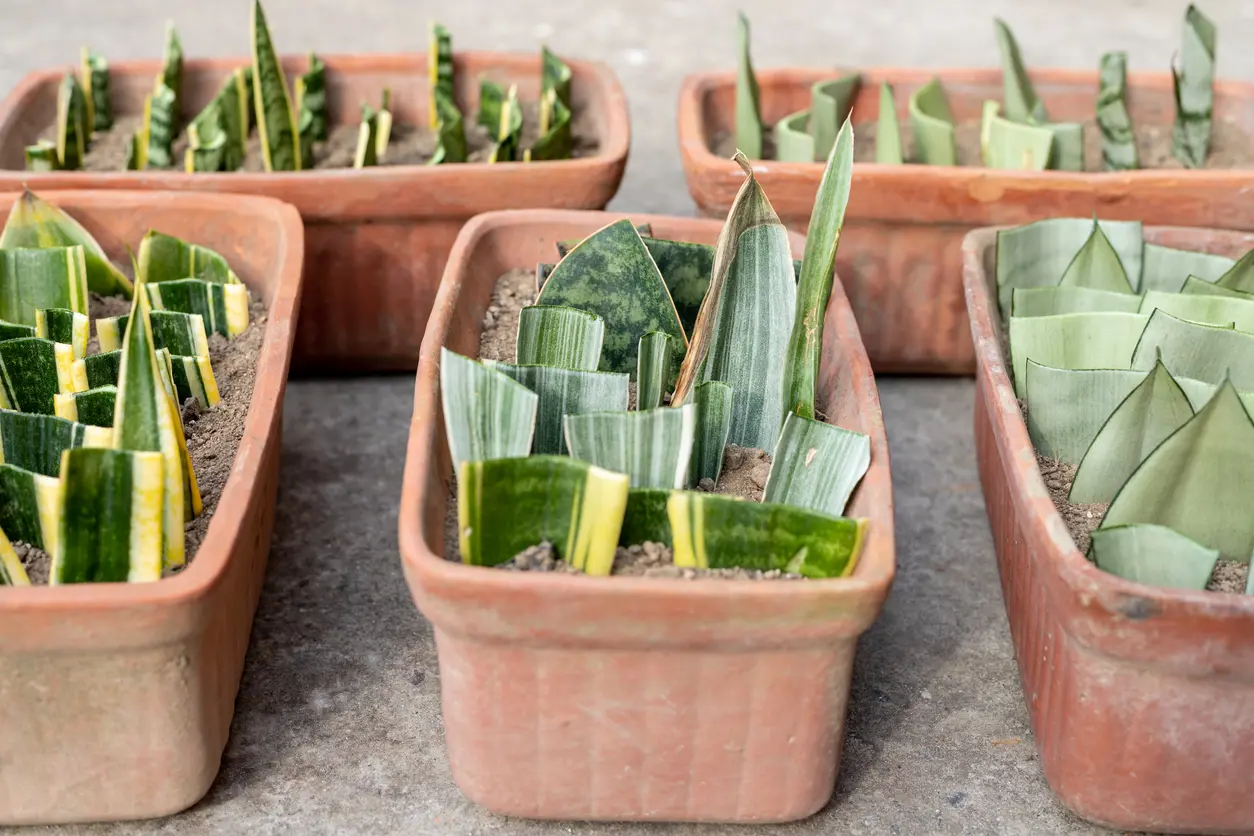
Propagating with cuttings is a faster process, but the new plants won’t look like carbon copies of the original. Variegated varieties will lose their coloration and become solid green as they grow.
To propagate by cuttings:
- Remove a leaf from the plant at the base and cut it into three or four sections.
- Dip the bottom portion of each cutting into a rooting hormone.
- Prepare a pot with rooting media like perlite.
- Place the leaf pieces into the rooting media and cover with plastic to keep up the humidity. Water the media when it dries out.
- Once the leaf cuttings develop roots, which usually takes up to three months, you can plant them in soil suitable for snake plants and care for them as you usually would. [2] Yard and Garden: Caring for Sansevieria; Iowa State University Extension and Outreach; Aaron J. Steil
Common Issues and How to Fix Them
Snake plants may be easy to care for, but they aren’t without problems. Spidermites are a common problem in dry climates. Their damage will leave snake plants with speckled white or yellow leaves and stunted growth. Isolate the plant and spray off the bugs with water. [9] Spider Mites and Their Control; Ohioline; David J. Shetlar Mealybugs and vine weevils can be handled the same way.
Root rot is the most common issue for snake plants. Many plant lovers show their love by watering, and snake plants just don’t speak that love language. You’ll notice root rot if the soil is consistently moist and leaves turn yellow and collapse.
Stop watering immediately and add drainage holes if you don’t have them already. Repot severely overwatered plants. [2] Yard and Garden: Caring for Sansevieria; Iowa State University Extension and Outreach; Aaron J. Steil
Do Snake Plants Flower?
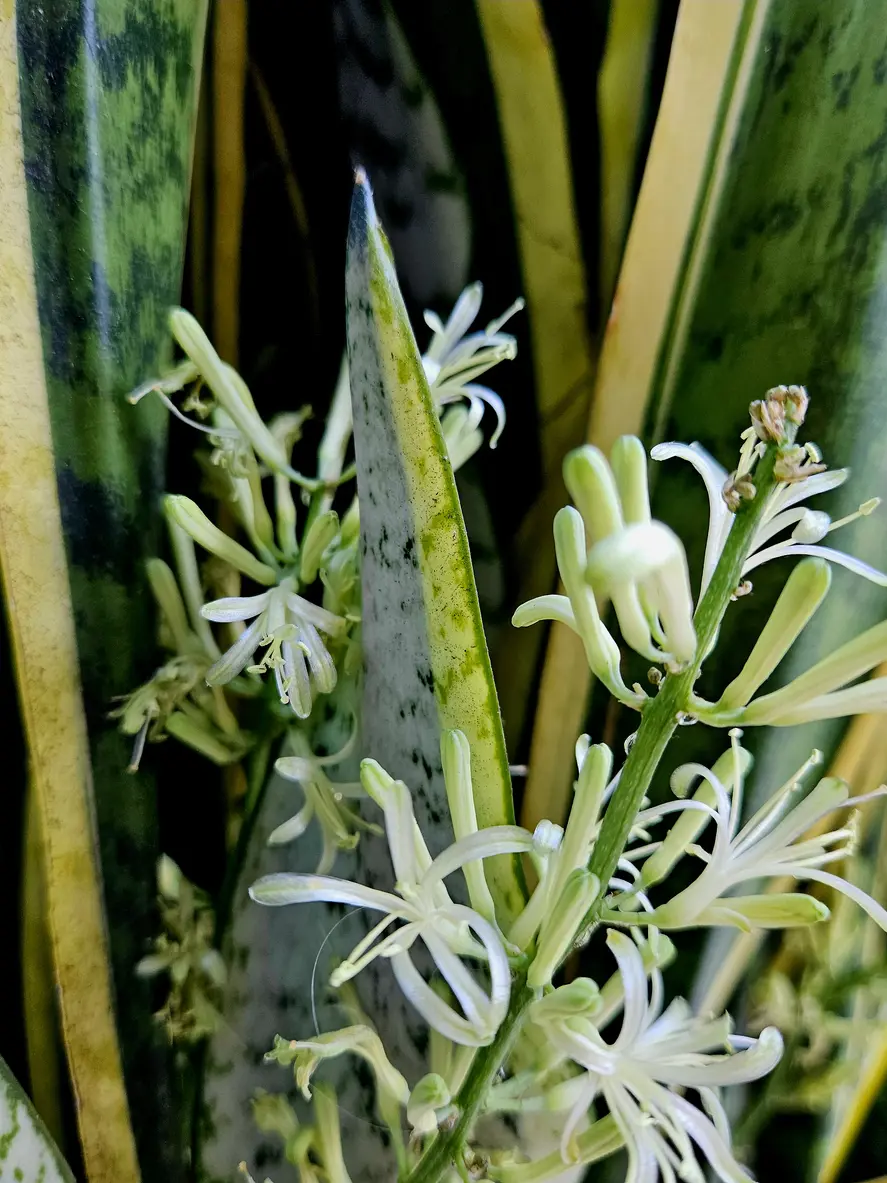
Snake plants grow tubular white flowers that resemble fireworks exploding. They’re a rare occurrence when a snake plant is grown indoors, but it’ll be more common among older plants. Enjoy the flowers’ sweet scent and take plenty of pictures. Once the flowers begin fading, cut the stalk at the base.
Benefits of Snake Plants
Many choose to grow them for their beauty, but snake plant benefits are enough of a reason to fill your home with them. According to a NASA study, snake plants can purify the air by removing harmful toxins, including ammonia and formaldehyde. [5] Dracaena trifasciata; North Carolina Extension Gardener Plant Toolbox , [7] Interior Landscape Plants for Indoor Air Pollution Abatement; NASA; B.C. Wolverton, Anne Johnson, Keith Bounds
Unless you keep your plant in the dark, expose it to freezing temperatures, or water it weekly, you probably won’t be able to kill it. They’re hardy plants that can go years without showing any signs of deterioration, making even the worst gardeners look like true green thumbs. [3] Plant of the Week: Snake Plant (Mother-in-Law’s Tongue); University of Arkansas Division of Agriculture , [4] How to grow sansevierias; Royal Horticultural Society
Though they have plenty of benefits, snake plants are mildly toxic when ingested. Keep them out of reach if you have curious children or pets. Stomach problems like vomiting or diarrhea may occur. [2] Yard and Garden: Caring for Sansevieria; Iowa State University Extension and Outreach; Aaron J. Steil The ASPCA advises that pets should be taken to the vet immediately if they eat a snake plant, and it wouldn’t hurt to do the same for children or yourself if the symptoms seem severe. [6] Snake Plant; American Society for the Prevention of Cruelty to Animals
Snake Plant Care Summary
Don’t forget these key components of snake plant care:
- Give your plants indirect but bright light.
- Only water the plant when the soil has dried out completely.
- Use well-draining soil and a small pot to avoid overwatering.
- Fertilize in the growing season.
- Only repot a snake plant when its container is too small.
- Keep the plant away from kids and pets.
Was this article helpful?
-
Snake Plant: A Forgiving, Low-maintenance Houseplant; Penn State Extension;
https://extension.psu.edu/snake-plant-a-forgiving-low-maintenance-houseplant -
Yard and Garden: Caring for Sansevieria; Iowa State University Extension and Outreach; Aaron J. Steil;
https://www.extension.iastate.edu/news/yard-and-garden-caring-sansevieria -
Plant of the Week: Snake Plant (Mother-in-Law’s Tongue); University of Arkansas Division of Agriculture;
https://www.uaex.uada.edu/yard-garden/resource-library/plant-week/mother-in-law-tongue.aspx -
How to grow sansevierias; Royal Horticultural Society;
https://www.rhs.org.uk/plants/sansevieria/growing-guide -
Dracaena trifasciata; North Carolina Extension Gardener Plant Toolbox;
https://plants.ces.ncsu.edu/plants/dracaena-trifasciata/ -
Snake Plant; American Society for the Prevention of Cruelty to Animals;
https://www.aspca.org/pet-care/animal-poison-control/toxic-and-non-toxic-plants/snake-plant -
Interior Landscape Plants for Indoor Air Pollution Abatement; NASA; B.C. Wolverton, Anne Johnson, Keith Bounds;
https://ntrs.nasa.gov/api/citations/19930073077/downloads/19930073077.pdf -
Over-Fertilization of Potted Plants; Penn State Extension ;
https://extension.psu.edu/over-fertilization-of-potted-plants -
Spider Mites and Their Control; Ohioline; David J. Shetlar;
https://ohioline.osu.edu/factsheet/HYG-2012-11


